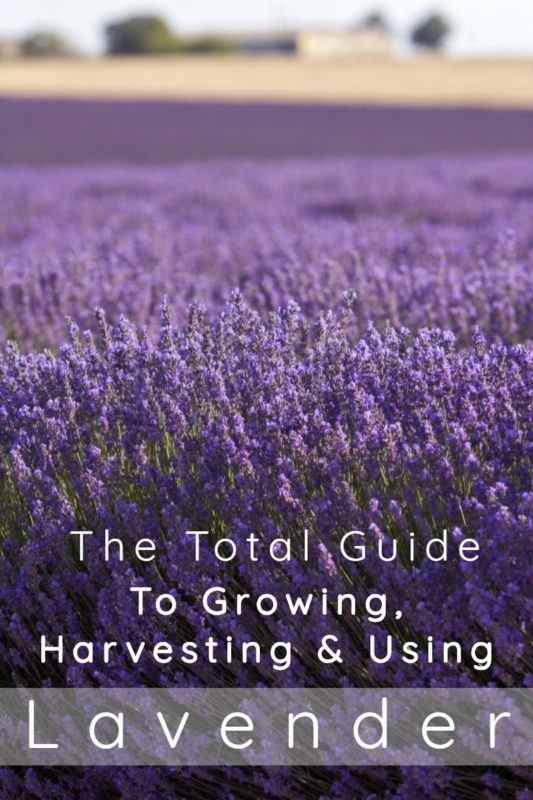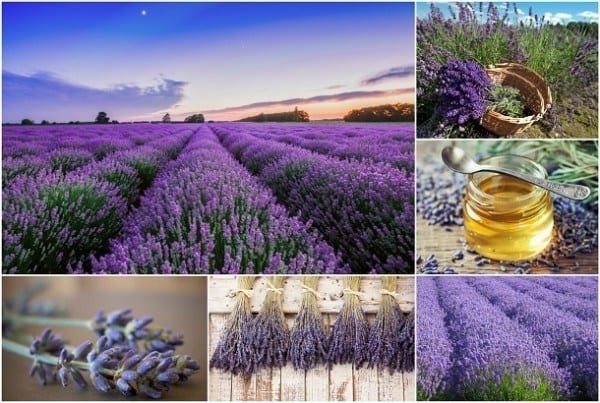
Lavender is a beautiful perennial evergreen plant that hails from southern Europe and the mountain regions located on the western border of the Mediterranean and also North and East Africa, Arabia, India and the Canary Island. Today, this highly versatile plant is grown all over the world for both personal as well as commercial use.
Historical Use
Lavender is an old plant that stretches across lands and cultures. The early Egyptians used shrouds soaked in lavender to embalm their mummies. Lavender would keep insects away and help to preserve the mummies in their pyramids. Ancient Greeks remedied all sorts of conditions such as muscle aches, insomnia and even insanity with lavender.
Romans used lavender in purifying baths. It was the Romans who gave lavender its name, which is derived from the Latin word “Lavare,” which means “to wash.” They also employed lavender as a perfume and an insect repellant.
When the plague hit Medieval Europe, people fastened a small sprig of lavender to their wrists to keep the Black Death at bay.
Historically, lavender was also used to wash clothes, as an antiseptic during World War I and also to treat burns.
Modern Uses Of Lavender
Lavender is packed with therapeutic value and is widely used in various forms for a number of conditions.
Because of its stimulating effect, lavender is often used to elevate mood, reduce mental trauma and revive a tired nervous system. In addition, lavender also has sedative properties that make it a relaxing tonic for both the mind and the body.
If you suffer from stress, tension headaches and migraines, lavender may bring you relief. This popular herb also has anti-inflammatory properties that can help reduce joint and muscular pain
The antiseptic properties in lavender help ease chapped and irritated skin, wounds, bites and sores along with conditions such as dermatitis, eczema and psoriasis.
Lavender’s potency does not stop here, it is also good for the digestive system and can ease such things as nausea, vomiting, indigestion, colic and gas.
In aromatherapy, lavender can help coughs, colds, bronchitis, asthma, sore throats, laryngitis and even pneumonia.
Read Next: 20 Magical Ways To Use Lavender Essential Oil
Lavender Species
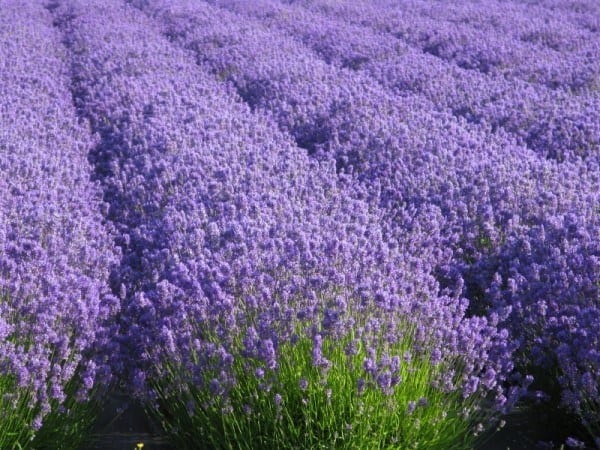
Over twenty different species of lavender exist along with numerous cultivars and hybrids. Each of the lavender types vary somewhat in habit, color and fragrance. There are three lavender types that stand out for home and commercial use including true lavender, spike lavender and lavandin.
English Lavender (Lavandula angustifolia, officinalis, vera)
True lavender is also known as common lavender or English lavender and is the type of lavender historically found in formal English gardens. This plant has narrow leaves, short, crooked stems and barrel-shaped flowers. Common lavender is best known for its sweet floral aroma. There are over one hundred different cultivars of this lavender.
This perennial lavender shrub grows best in full sun and well-drained and alkaline soil in USDA growing zones 5 through 9. It often reaches a height of 1 to 3 feet with a loose and upright habit. Depending on the variety you choose and where you grow this plant, it can have evergreen or at least semi evergreen foliage that lasts well into the winter.
Many people use common lavender, especially the dwarf types, in rock gardens or as a border in a formal garden setting. Although, it is equally at home in a wildflower garden as well where it attracts a wide variety of pollinators.
Like most perennials, English lavender will reward you with a long blooming season if you deadhead flowers once they are spent. You can also shape plants after they flower by cutting them back just a little. Every three or four years, prune heavily to keep the plant looking neat.
Spike Lavender (Lavandula spica, latifolia)
Compared to common lavender, this plant has wider leaves and is coarser. Because of this, it is often called broadleaved lavender. The aroma from this plant is eucalyptus-like and is commonly used in soaps, insect repellents, room sprays and deodorants.
This evergreen shrub is hardy in USDA growing zones 6-9 and prefers full sun and well-drained soil. The medicinal properties of this plant are similar to common lavender. The flowering stems and the oil contain antibacterial, antiseptic, antispasmodic and carminative properties. Although this plant yields a greater amount of essential oil, it is not as potent.
Lavandin ( L.x intermedia)
When common lavender and spike lavender are naturally crossed the result is lavandin. Although this type of lavender, also called Dutch lavender, is a super hardy plant, it is also sterile. This means that it can’t reproduce with seeds, but requires cuttings instead.
The stems are long and the vibrantly colored flowers are also noticeably larger than the other varieties and also pointed at the tip. The oil from this plant is plentiful and used in a variety of personal care and household mixtures. The flowers are a common ingredient in potpourri and have a somewhat spicy aroma that is quite different from true lavender and fairly short-lived.
Lavandin contains clarifying, purifying and balancing properties and is used in aromatherapy.
How To Harvest Lavender
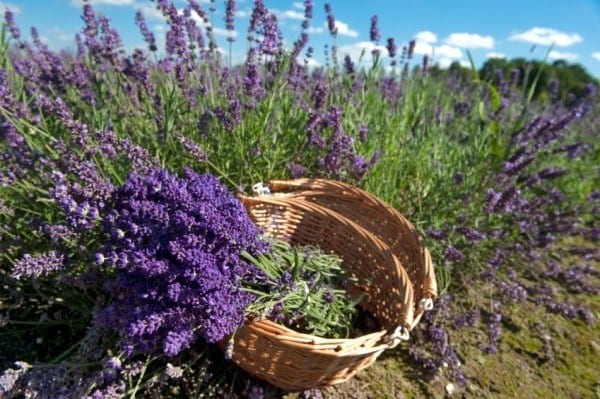
The best time to harvest lavender is after buds have formed but before the flowers have opened. If you can catch lavender at this stage, the flowers will be highly aromatic and colorful.
Gather a handful of long flower stems in your hand and use clean and sharp bypass pruners to snip the flowers at their base. Wrap the bundle with twine. Always harvest the whole plant at one time.
Dry lavender bunches in a warm and dry location that is not in direct sunlight. Places such as a garage or garden shed work well for drying. Some people even tie bunches of lavender to fences in shady locations.
Generally, the lavender will be completely dry in 2-4 weeks. At this time you can shake it very gently rub the buds into a clean and dry bowl. Store the dry lavender in a jar and place in a cool and dark location.
Tips For Planting & Growing Lavender
As mentioned, lavender plants prefer well-drained soil. If your soil does not drain well you can add builder’s sand before you plant. Make a small mound for each plant before putting it in the ground. You can also plant lavender in a raised bed. This will help you manage soil quality and drainage.
The best soil for lavender is alkaline with a pH of 6.5 or higher. If you are not sure what your soil pH is, you can do a simple soil test to find out.
Set the plants about 18 inches apart in an area where they will receive full sun and adequate air circulation. Be sure to allow soil to dry completely before you water. Too much heat and humidity can cause fungus to attack the plants and turn the leaves brown. To keep this from happening, sprinkle more sand or small pebbles around the plant – this will help the humidity evaporate faster.
To keep plants healthy all year long, sprinkle a little bone meal around each plant in the fall. Be sure to work the bone meal into the first inch of soil.
Planting Lavender Seeds
If you prefer to grow lavender from seeds, you will need to start three months before your expected last spring frost date.
The first thing that you have to do is mimic nature by placing seeds in a plastic bag filled with peat moss. Place the bag in the refrigerator for five weeks and be sure that you keep the moss moist. After five weeks, take the seeds out of the refrigerator and let them warm up to room temperature.
Prepare a planting tray by mixing equal parts washed medium-grit sand with lightweight seed-starting mix. Spray the mixture lightly with a spray bottle to moisten. Make small troughs in the planting mixture just one-eighth of an inch deep. Drop the seeds every one inch and cover with a very light layer of sand. Mist the seeds lightly.
Tray placement is important – be sure to put the tray where it will receive at least six hours a day of sun. However, be sure to shield the try from the hot midday sun.
Place a warming mat under the seed tray to keep the temperature between 75 and 80 F during the day and 55 F at night. Cover the tray with plastic wrap, leaving one side unsealed. This will allow moisture to escape. Keep the sand mixture wet – only water when it feel dry on the surface. Be sure to water with a spray bottle.
In about 15 to 20 days, the seeds will germinate. At this time, it is best to thin the seedlings to every 3 inches. One week from germination, it is time to transplant the strongest seedlings to small planting pots (4-inch pots work well). Be sure that the planting pots contain sandy potting mix. Keep the seedlings moist and in a partially sunny location. Transplant them into the garden in a sunny spot after about two months. Be sure that the spot where you plant them has well-draining soil.
Lavender Uses
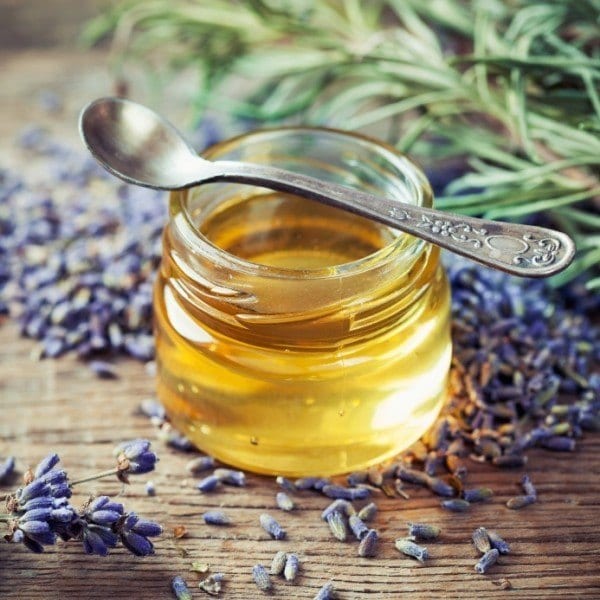
As you can see, lavender (of all varieties) contains many beneficial properties, and has a wide number of applications. Here are just some of the ways that you can use lavender to reap its therapeutic value.
- Use dry lavender flower heads mixed with dry chamomile to make a soothing anti-stress tea.
- Keep your drawers smelling sweet and fresh by filling a small mesh bag with dried lavender flower heads. Refresh regularly with lavender essential oil.
- Add fresh or dried lavender buds and lavender essential oil to heated wax to make your own aromatic candles.
- Make a sweet and uplifting room spray by adding 2 drops of lavender, tea tree and peppermint essential oil to 2 cups of water n a spritzer bottle.
- Ease the itch and swelling from bug bites by dabbing a little lavender oil on the bite.
- If you can’t sleep, drop a few drops of lavender essential oil on your pillow.
- Ease headaches (especially tension headaches) by rubbing a few drops of lavender oil on your temples.
- Reduce inflammation and ease joint and muscle pain by massaging lavender oil into sore spots.
- Reap all the therapeutic value of lavender by placing a five or six drops in a diffuser.
- For a yummy treat, stir crumbled lavender flowers and cinnamon into homemade vanilla ice cream.
- Use lavender bloom to garnish some of your favorite dishes.
- Make you own lavender infused oil by adding a handful of organic lavender buds to 2 cups of white wine vinegar. Allow the buds to sit in the vinegar for about six weeks – strain and use.
- Enjoy a relaxing bath by mixing 1 cup Epsom salt, ½ cup sea salt, 3 tablespoons baking soda and 10 drops of lavender essential oil together. Mix and store in glass jar with lid. Use about ? cup each bath.
- Keep your skin feeling fresh and vibrant by mixing your own lavender skin scrub. Mix together 1 cup of white sugar, ½ cup melted organic coconut oil, 15 drops lavender oil and 2 tablespoons dried lavender buds. Store the scrub in a glass jar and use daily.
- Reduce the severity of menstrual cramps by adding a few drops of lavender oil to a carrier oil such as almond oil and rubbing on your abdomen.
- Keep moths and silverfish out of closed spaces by placing fresh lavender flowers in closets or attics.
- Make a fresh facial tonic by adding 5 drops of lavender essential oil to 5 oz of water. Put mixture in a spritzer bottle and use to revive refresh your face.
- Add a few drops of lavender oil to pure aloe vera gel to ease minor sunburn.
Don’t forget to cut fresh bouquets of lavender and place them throughout your home. The sweet aroma will lift spirits and leave your home smelling fresh and clean.
Pin This For Later
